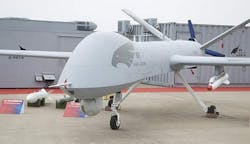Global UAV market to reach $2.3 billion by 2023, as AVIC of China is poised to become world's largest aerial drone maker
Flying drone manufacturers worldwide will build about 1,000 UAVs of all types in 2014, with output rising to nearly 1,100 units in each of the following two years, Forecast International analysts say.
By 2017 worldwide UAV production should average about 960 unmanned aircraft annually for the remaining seven years of the 2014-2023 forecast period, analysts say.
The Aviation Industry Corporation of China (AVIC) in Beijing is expected to be the biggest UAV manufacturer in the world over the next decade, with an anticipated $5.76 billion worth of UAVs to be manufactured, nearly all earmarked for Chinese consumption, analysts say.
AVIC manufacturers a wide range of UAVs, including its electrically powered micro air vehicle (MAV), the jet-powered LIEOE, which appears almost identical to the Northrop Grumman RQ-4 Global Hawk, for reconnaissance, surveillance, and attack missions, the AVIC Sky Eye, an electrically unmanned helicopter designed to be deployed by artillery or rocket round, for reconnaissance and targeting, and the TL-8 Sky Dragon for simulating cruise missiles for Chinese military.
The Northrop Grumman Corp. Aerospace Systems segment in San Diego, builder of the U.S. Air Force's expensive RQ-4B Global Hawk and the U.S. Navy's MQ-4C Triton long-range surveillance UAVs, is next in line with forecast production worth $2.58 billion, Forecast International analysts say.
The wars in Iraq and Afghanistan sent UAV production to record heights, but with the last U.S. military troops in Afghanistan to come home this year, the Pentagon's demand for unmanned air vehicles is slackening, analysts say.
Still, while fewer UAVs are expected to roll off the production lines from 2014 to 2023, Forecast International experts predict that manufacturers still can expect their coffers to grow, based on the relatively high costs expect for new systems.
While UAV production is expected to remain relatively stable over the next 10 years, the value of production will steadily climb, from about $942 million in 2014 to $2.3 billion in 2023.
The U.S. Department of Defense is expected to maintain its reliance on UAVs of all types, analysts say. Interest in UAVs, meanwhile, also is growing overseas. Poland's air force plans to expand its fleet of UAVs for reconnaissance and surveillance missions, as well as strikes on ground targets," says Larry Dickerson, Forecast International's senior unmanned vehicles analyst.
The value of land- and sea-based unmanned systems will rise toward the latter part of the 10-year period, analysts say. Land-based systems include bomb-disposal robots and remotely operated ground vehicles conducting reconnaissance in hazardous areas.
Sea-based unmanned underwater vehicles (UUVs) and unmanned surface vehicles (USVs) range in applications from mine detection and disposal to use as torpedo decoys.
All told, some 41,800 land- and sea-based unmanned systems worth about $10.5 billion are forecast for production during the 2014-2023 forecast period. Of this amount, the value of production for yet-undetermined manufacturers is nearly $1.3 billion, Forecast International experts say.
For more information contact Forecast International online at www.forecastinternational.com.
About the Author
John Keller
Editor-in-Chief
John Keller is the Editor-in-Chief, Military & Aerospace Electronics Magazine--provides extensive coverage and analysis of enabling electronics and optoelectronic technologies in military, space and commercial aviation applications. John has been a member of the Military & Aerospace Electronics staff since 1989 and chief editor since 1995.
